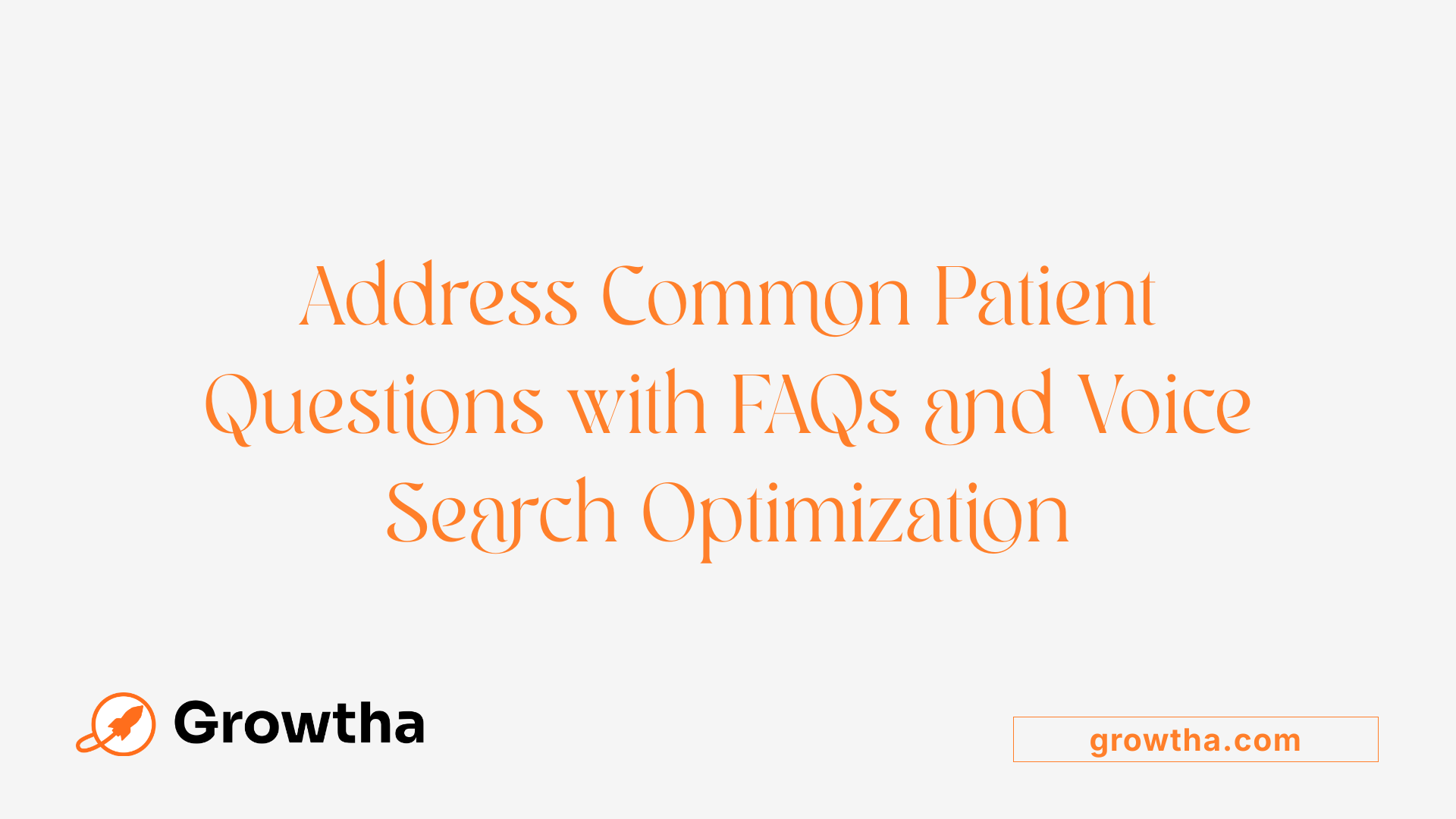How to Improve Dwell Time on Healthcare Pages
Maximizing Engagement and Retention on Your Healthcare Website


How to Improve Dwell Time on Healthcare Pages
Understanding the Importance of Dwell Time in Healthcare Content
In the rapidly evolving digital healthcare landscape, keeping visitors engaged on your website is crucial for delivering impactful health information, building trust, and encouraging patient actions. Dwell time, the period a user spends on a page after clicking from search engine results, serves as a key indicator of content relevance and user engagement. While not explicitly a ranking factor, higher dwell time correlates with better content quality and improved visibility. This article explores effective strategies and best practices for enhancing dwell time on healthcare pages, ensuring your website becomes a trusted resource for patients.
Creating High-Quality, Comprehensive Content

Why is user engagement important for healthcare content, and how can it be increased?
User engagement plays a crucial role in the effectiveness of healthcare websites. When visitors find the content relevant and engaging, they are more likely to stay longer, trust the information provided, and take meaningful actions such as scheduling appointments or accessing health resources.
To boost engagement, healthcare providers should focus on creating a modern, easy-to-navigate website. Clear headings, intuitive menus, and simple layouts help users find what they need quickly. Ensuring the site is mobile-friendly is essential, as many patients access healthcare information via smartphones and tablets.
Incorporating multimedia elements such as videos, patient stories, infographics, and interactive tools transforms static content into dynamic experiences. Videos explaining medical procedures or animated visuals explaining complex information can make content more relatable and easier to understand.
Fast load times are vital, especially on mobile devices, to prevent users from bouncing away due to frustration. Optimizing images, leveraging browser caching, and minimizing scripts contribute to quicker page rendering.
Accessibility standards, including screen reader compatibility and readable font sizes, ensure that all users, regardless of disabilities, can access information.
Personalization features, like secure patient portals and tailored information based on user location or interests, foster a stronger connection and enhance the sense of individualized care.
Regularly analyzing engagement metrics such as time on page, click-through rates, and bounce rates helps identify which content resonates most. Continuous updates, incorporating new health information, and design improvements based on user feedback maintain relevance and interest.
In summary, increasing user interaction through thoughtful content presentation, multimedia, mobile optimization, and ongoing analysis creates a more engaging and effective healthcare website, ultimately supporting better patient outcomes and satisfaction.
Enhancing Readability and Content Organization
Using clear headings and subheadings
Organizing content with descriptive headings and subheadings makes information easier to scan and understand. Clear labels help visitors quickly locate the topics they’re interested in, encouraging them to stay longer on the page. For healthcare websites, this might include sections like "Symptoms and Causes," "Treatment Options," and "Patient Resources."
Breaking content into short paragraphs and bullet points
Large blocks of text can be intimidating and discourage reading. Breaking content into short, digestible paragraphs improves readability. Bullet points are particularly effective for listing benefits, steps, or features, making important information stand out. For instance, listing the benefits of a treatment or steps in a patient registration process can be easily grasped when formatted properly.
Employing bold text to highlight key points
Strategically using bold text draws attention to essential information such as safety tips, critical FAQs, or important instructions. This visual cue helps visitors quickly identify the most relevant parts of the content, increasing engagement and ensuring they don't miss vital details.
Content optimization techniques for healthcare websites
Enhancing dwell time involves multiple strategies. Producing diverse, high-quality content such as blogs, infographics, patient stories, and answer-rich FAQs caters to different learning preferences and keeps visitors engaged. Incorporating multimedia elements like videos with transcripts, virtual tours, and testimonials adds interactivity. Optimizing these elements with relevant keywords and compelling calls-to-action encourages viewers to explore further.
Local SEO practices, including geotargeted keywords, Google My Business page optimization, and schema markup, help attract relevant local traffic. This targeted audience is more likely to engage deeply with the content and stay longer.
Website usability also plays a crucial role. Ensuring a mobile-first, responsive design with fast load times, simplified navigation, and interactive features provides a seamless experience for users on any device.
Structuring content to answer common questions naturally using long-tail keywords and well-designed FAQ pages directly addresses user intent. This approach not only improves dwell time but also enhances search visibility.
In sum, thoughtful content organization combined with strategic SEO and user experience improvements can significantly increase user engagement and promote longer visits on healthcare websites.
Speed and Mobile Optimization

What strategies for improving dwell time on healthcare pages?
Enhancing dwell time on healthcare websites involves multiple strategic steps centered on user experience and content quality. First, focus on creating comprehensive, high-quality content that addresses commonly asked questions and patient needs. Organizing this content into clear sections with headings, subheadings, bullet points, and visual elements like images and videos makes it easier to read and more engaging.
Optimizing site speed is crucial. Compressing images, minimizing scripts, and leveraging browser caching can significantly reduce load times. A fast website reduces user frustration and encourages longer visits.
Responsive design ensures your website looks good and functions well on all devices, including smartphones and tablets. Using fluid grids, flexible images, and CSS media queries creates a layout that adapts seamlessly to different screen sizes.
Optimizing images by using modern formats such as WebP and JPEG XR further speeds up load times while maintaining quality. Scripts should be minified, and unnecessary elements removed to improve efficiency.
Implementing intuitive navigation, internal linking to related content, and a clear layout guides visitors effortlessly through your site. Active use of structured data and schema markup enhances search visibility and click-through rates, which can directly or indirectly increase dwell time.
For healthcare pages, local SEO tactics such as geotagging and localized content help attract nearby users actively seeking healthcare services. Faster, engaging, and optimized sites foster trust and relevance, driving visitors to stay longer.
Regularly monitoring website performance using tools like Google PageSpeed Insights, Search Console, and analytics platforms provides insights into ongoing issues and opportunities for enhancements. Adjusting your strategies based on these data points ensures your healthcare website remains user-friendly and engaging, ultimately boosting dwell time.
How does responsive layout design impact Dwell Time?
A responsive layout adapts seamlessly to various screen sizes and devices. This flexibility prevents users from experiencing issues such as unreadable text, misplaced images, or difficult navigation. When visitors access healthcare content on their mobile devices, a responsive design provides a smooth, consistent experience.
This ease of use reduces frustration, encouraging users to stay on your site longer. Clear menus, touch-friendly buttons, and appropriately sized content blocks make interaction simpler.
A well-designed responsive site also enhances trustworthiness, an important factor for healthcare consumers. Google prioritizes mobile-friendly pages in search rankings, leading to higher visibility and more visitors who are likely to engage deeply.
In what ways can optimizing images and scripts improve site speed?
Images often constitute the largest load on a webpage. Using compressed formats like WebP reduces file size without sacrificing visual quality, speeding up page load times.
Similarly, scripts—such as JavaScript and CSS files—should be minified to remove unnecessary characters and spaces. This process decreases the overall size of these files, enabling faster downloads.
Implementing asynchronous or deferred loading for scripts ensures they don’t block the rendering of the page content. This results in quicker visibility of the essential content, encouraging users to remain engaged.
Combining these optimizations with Content Delivery Networks (CDNs) helps distribute content geographically, reducing latency for visitors in different regions.
By enhancing speed through image compression and script optimization, healthcare websites can significantly improve user engagement and increase the likelihood of longer dwell times, ultimately contributing to better SEO performance.
Boosting Engagement Through Multimedia and Interactive Content

What content optimization techniques can enhance dwell time in healthcare websites?
Increasing dwell time, the duration visitors spend on your healthcare website before returning to SERPs, requires a strategic blend of engaging content and user-friendly design. One effective approach is to produce diverse, high-quality content that meets various patient needs and interests. This includes long-form articles, engaging infographics, heartfelt patient testimonials, FAQs, and educational videos. These elements not only make the site more attractive but also help answer common questions quickly, fulfilling search intent.
Optimizing your site for local SEO is equally important. Incorporate geotargeted keywords, optimize your Google My Business profile, and use schema markup to enhance search visibility. This attracts relevant local visitors who are more likely to stay longer and explore your services.
Multimedia elements like videos, virtual tours, and patient stories significantly boost engagement. For example, videos should be optimized with descriptive transcripts, compelling thumbnails, and relevant keywords to improve search rankings. Virtual tours give potential patients a peek into facilities, building trust and encouraging longer visits.
Call-to-actions (CTAs) embedded in multimedia content can motivate users to take next steps, whether scheduling an appointment or exploring additional resources. Moreover, ensuring a mobile-first, responsive design is vital. Fast load times, simple navigation, and touch-friendly elements create a seamless experience across all devices.
Structuring content to naturally answer prevalent questions, using long-tail keywords, and creating dedicated FAQ pages can satisfy user queries effectively. This not only improves dwell time but also positions your site favorably for featured snippets.
In summary, a combination of comprehensive, relevant content with multimedia enhancements and technical optimizations fosters user engagement, keeps visitors exploring longer, and ultimately improves your healthcare website’s SEO performance.
Leveraging Internal Linking and SEO Techniques
What SEO strategies can be employed to boost dwell time and search rankings for healthcare content?
Boosting dwell time and search rankings in healthcare websites involves a combination of technical, content, and user experience strategies. First, conducting comprehensive keyword research is essential. Focus on keywords that match patient search intent, especially long-tail keywords and question-based queries that are often used in voice searches.
Creating high-quality, in-depth content is fundamental. Use diverse formats such as detailed blog articles, infographics, engaging videos, and patient success stories. These elements not only enrich the content but also encourage visitors to stay longer on your site.
Technical optimization plays a significant role. Ensure your website loads quickly by compressing images and scripts, and optimize it for mobile devices with a responsive design. Using structured data and schema markup can enhance search snippets, making them more attractive and informative.
Effective internal linking naturally guides visitors to relevant related content within your site. This strategy keeps users engaged, exploring more pages, and reduces bounce rates. Additionally, developing a strong local SEO presence by optimizing your Google My Business profile, earning positive reviews, and creating location-specific content helps attract nearby patients and increases relevant traffic.
Regularly analyze user behavior metrics to identify pages with low engagement, and refine your content and navigation accordingly. Combining these strategies results in a more engaging user experience, higher dwell times, and improved search rankings.
Implementing Structured Data and Rich Snippets
How can healthcare websites measure and analyze dwell time effectively?
To effectively measure and analyze dwell time on healthcare websites, organizations should leverage analytics tools like Google Analytics. These tools help track how long visitors stay on specific pages, providing insights into user engagement levels.
Additionally, understanding dwell time can be improved by adopting methods similar to clinical alert systems. In those systems, dwell time is the duration from when an alert is generated until it is dismissed. Similarly, on websites, measuring the time from a user's arrival on a page to their exit offers a more precise metric.
Segmenting dwell time data by user roles, such as patients, clinicians, or caregivers, as well as by content type or visit frequency, can help identify patterns. For instance, longer dwell times on in-depth guides may indicate high relevance, while shorter times on quick facts pages can suggest the need for more engaging content.
Regular analysis of these metrics enables healthcare providers to evaluate whether their content effectively meets visitor needs and keeps them engaged. By understanding how different audience segments interact with content, websites can optimize pages to enhance user experience.
Combining standard web analytics with role-specific and content-specific insights provides a comprehensive strategy. This integrated approach helps ensure content remains relevant, engaging, and accessible, ultimately increasing dwell time and improving overall SEO performance.
Aligning Content With Search Intent and Emerging Trends

How can healthcare websites address common user questions with FAQs?
Creating a comprehensive FAQ section is a proven way to meet patient needs effectively. FAQs should cover common questions about medical conditions, treatments, procedures, and insurance-related inquiries. Use clear, concise language and answer questions directly to improve readability and relevance. Incorporate structured data markup, such as FAQ schema, to enhance visibility in search results with rich snippets. This makes content more engaging and encourages longer dwell times.
What best practices exist for optimizing for voice search and natural language queries?
Voice search optimization involves adopting a conversational tone and incorporating long-tail keywords. Focus on question-based phrases that mirror how people naturally speak, such as "What are the symptoms of diabetes?" or "How do I schedule a flu shot?". Integrate structured data like FAQs and How-to schemas to increase chances of being featured in voice search results. Additionally, optimize site speed and mobile usability, as voice searches are predominantly performed on mobile devices.
How can staying updated with search algorithm changes and evolving user behavior benefit healthcare content?
Search engine algorithms are continually evolving, especially with updates like Google’s Core Web Vitals emphasizing user experience and site performance. Healthcare providers should regularly monitor their website analytics to identify patterns, such as pages with low dwell time, and adapt content accordingly.
Keeping abreast of changes in user behavior, such as increased mobile usage or preferences for multimedia content, enables ongoing optimization. This might include enhancing mobile responsiveness, adding videos, or implementing AI-powered chatbots for instant information. Staying updated ensures that healthcare websites remain visible and engaging, thereby increasing dwell time and overall search rankings.
| Strategy Type | Implementation Examples | Benefits |
|---|---|---|
| Content Quality | Long-form articles, patient stories, infographics, videos | Increased engagement and longer dwell time |
| Technical SEO | Fast load speeds, responsive design, structured data, SEO-friendly URLs | Better user experience and higher rankings |
| Voice Search Optimization | Question-based content, natural language keywords, FAQs | Increased visibility in voice inquiries |
| User Engagement | Comments, discussions, internal links, multimedia elements | Longer site visits and exploration |
| Mobile Optimization | Accelerated Mobile Pages (AMP), mobile-friendly layouts | Reduced bounce rates, improved dwell time |
By focusing on these strategies, healthcare websites can better align with user expectations, boost engagement, and stay competitive in search rankings. Regularly updating content and technology based on emerging trends and user preferences is crucial for sustained success.
Future Trends and Continual Optimization
How can healthcare websites measure and analyze dwell time effectively?
Measuring and analyzing dwell time on healthcare websites is essential for understanding how visitors engage with your content. The most common method involves using analytics tools like Google Analytics, which track how long users stay on specific pages. By examining metrics such as session duration, bounce rate, and exit rate, healthcare providers can gauge content relevance and user interest.
Beyond standard tools, more detailed approaches can be adopted. For instance, analyzing 'alert dwell time'—the period from when an alert is generated to when it is dismissed—can offer insights similar to clinical alert systems. This concept can be applied to web analytics by tracking how long users remain active on a page before leaving.
Segmenting dwell time data based on user roles (patients, healthcare professionals, administrators), visit frequency, or content type helps identify specific behaviors and preferences. For example, longer dwell times on detailed articles or interactive tools indicate high engagement, whereas brief visits to FAQ pages may suggest the need for content improvement.
Regular monitoring and analysis of these metrics enable healthcare organizations to refine content and user experience continually. Implementing A/B testing, tailored content strategies, and heatmaps further illuminates how visitors interact with your site.
By combining traditional analytics with role-specific insights and real-time behavioral data, healthcare websites can optimize their content effectively, ensuring visitors find what they need and stay longer, ultimately improving their search rankings and user satisfaction.
Conclusion: Maximizing Your Healthcare Website’s Potential
What are effective strategies for improving dwell time on healthcare web pages?
Enhancing dwell time on healthcare websites hinges on delivering engaging, relevant, and comprehensive content that resonates with patient needs. Creating detailed articles, guides, and FAQs helps provide the information visitors seek, encouraging them to stay longer.
Organizational clarity also plays a crucial role. Using clear headings, subheadings, bullet points, and short paragraphs makes content easier to navigate and digest. Incorporating multimedia elements like videos, infographics, and images not only makes the pages more engaging but also caters to different learning preferences.
Page load speed significantly impacts user retention; slow pages frustrate visitors and increase bounce rates. Optimizing images, leveraging browser caching, and utilizing Content Delivery Networks (CDNs) can speed up load times.
Mobile optimization ensures a seamless experience across all devices. Responsive design, touch-friendly navigation, and rapid load times on smartphones and tablets prevent mobile visitors from abandoning the site.
Encouraging internal linking to related pages invites visitors to explore further, increasing dwell time. Additionally, local SEO strategies, such as geotargeted keywords and Google My Business optimization, attract nearby audiences actively seeking healthcare services.
Structured data and schema markup enhance search visibility and can lead to featured snippets, enticing users to click and stay longer on your pages. Active reputation management through patient reviews builds trust and can influence visitor engagement.
Regularly analyzing user behavior through tools like Google Analytics allows continuous refinement of content and design. Tracking metrics such as dwell time, bounce rate, and session duration reveals opportunities for intervention.
Overall, a combination of high-quality content, technical performance, strategic SEO, and user engagement tactics fosters an environment where visitors are encouraged to stay longer, ultimately boosting your healthcare site's effectiveness and search ranking.
Continuous Optimization for Long-Term Success
Maximizing dwell time on healthcare pages requires a multifaceted approach that combines high-quality, engaging content with optimal technical and design elements. By understanding user needs, aligning content with search intent, leveraging multimedia, and continuously analyzing performance metrics, healthcare providers can foster greater engagement. Embracing emerging trends such as AI personalization and immersive content, alongside diligent SEO practices, ensures your website remains relevant and authoritative. Regular updates, user feedback incorporation, and staying abreast of algorithm changes are essential for sustained success. Ultimately, an ongoing commitment to enhancing user experience and content relevance will position your healthcare website as a trusted resource and improve overall patient outcomes.
References
- Top 10 Strategies to Increase Dwell Time - Cube Creative Design
- 50 Ways to Boost Dwell Time for Your Website Content - Linkilo
- Healthcare SEO: How to get found online | Kontent.ai
- Mastering Healthcare SEO: Strategies to Elevate Your Online ...
- What Is Dwell Time? (With Tips to Help You Improve) - Indeed
- Understanding Dwell Time: Why It Matters for Your Website
- Mobile SEO Action: Best Ways To Optimize Healthcare Sites







